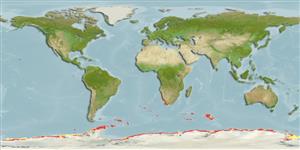Common names from other countries
Classification / Names / Names
Populaire namen | Synoniemen | Catalog of Fishes (gen., sp.) | ITIS | CoL | WoRMS
Environment: milieu / climate zone / depth range / distribution range
Ecologie
; diepteverspreiding 14 - 423 m (Ref. 7424). Polar
Southeast Atlantic and the Antarctic: Antarctica and South Africa.
Length at first maturity / Size / Gewicht / Leeftijd
Maturity: Lm ? range ? - ? cm
Stolonal colonies composed of stolons creeping on substratum and giving rise to sock-shaped hydrothecae, adnate to substratum to a varied degree. Adnate part of hydrothecae provided with striae on dorsal side; striation highly variable. Hydrothecal aperture circular, rim even. Cnidome composed of two kinds of nematocysts, small and large ones. Coppinia composed of a set of firmly adpressed gonothecae surrounded by a fence of long defensive tubes usually curved towards the centre of the gonothecal mass in such a way that they constitute a nest or corbula. Defensive tubes forked or unforked, provided with distal, circular aperture. Gonotheca tubular, basally truncated and with a distal, unraised, circular aperture, usually on a slightly raised, cone-shaped part. Eggs remaining on gonothecae, immersed in a sort of nourishing mass.
Found at depths of 13.5 to 400 m (Ref. 7424).
Life cycle and mating behavior
Geslachtsrijpheid | Voortplanting | Kuitschieten | Eieren | Fecundity | Larven
Found with coppinia in January to February and June. Material was collected in December to February.
Peña Cantero, A.L., A. Svoboda and W. Vervoort. 2004. (Ref. 7424)
Status op de Rode Lijst van het IUCN (Ref. 130435)
Status bij CITES (Ref. 108899)
Not Evaluated
Not Evaluated
Gebruik door de mens
| FishSource |
Tools
Meer informatie
Populaire namenSynoniemenPredatorsVoortplantingGeslachtsrijpheidKuitschietenFecundityEierenOntwikkeling van de eieren
Leeftijd/GrootteGroeiLengte-gewicht parametersLengte-lengte parametersMorfologieLarvenAbundantie
Internet-bronnen
Estimates based on models
Preferred temperature
(Ref.
115969): 0.2 - 10.5, mean 1.8 (based on 51 cells).
Prijsklasse
Unknown.
